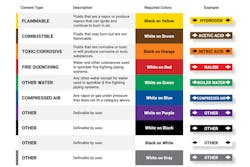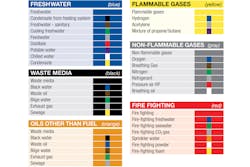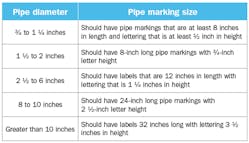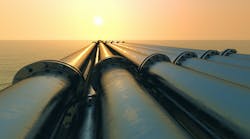In typical industrial settings, liquids are carried from one corner of the facility to another through a network of pipes snaking underground, overhead and along walls. At first glance, it is anyone’s guess as to what the pipe is carrying — it could be ammonia, acetone or simply tap water. For facility managers, maintenance employees working in the area and emergency responders, the proper labeling of pipes means more than staying compliant — it ensures the facility is safe and efficient. Keeping track of the pipe’s contents and where it goes is crucial. When pipes are well-marked, maintenance personnel can easily trace pipes to the source, no second-guessing of what is in the pipes occurs, emergency responders can identify contents and errors in pipe identification can be avoided or significantly reduced.
Instead of merely adding new labels here and there, tackling the beast that is pipe labeling often benefits from an overhaul of current practices and implementing a new pipe labeling campaign. Fortunately, standards and regulations were created to make the process less overwhelming.
Regulations
The cornerstone of safety often lies in regulations and adhering to these regulations reduces company liability and eliminates fees. Generally, most facilities can adhere to ANSI/ASME 13.1 standards created by the American National Standards Institute (ANSI) and the American Society of Mechanical Engineers (ASME). However, different regulations are applicable and required for specific workplaces. The following are instances that require stricter standards because of the particularly volatile nature of substances or because of the complex workplace environment.
Ammonia pipe-marking
Ammonia can corrode eyes, skin and lungs. Because it can cause serious health issues even at relatively low concentrations, specific regulations apply to labeling pipes carrying ammonia. The International Institute of Ammonia Refrigeration (IIAR) set forth regulations that standardized the practice of labeling pipes that carry ammonia-based substances with the following label requirements:
- Abbreviations — Abbreviations for the Ammonia System Components (black text on yellow)
- Physical state — This refers to the form of the substance: LIQ=liquid (black or white text printed on orange) or VAP=vapor (black or white text printed on blue)
- Pressure level — If high-pressure (+70 psig), color-coding will be black or white text printed on red; if low-pressure (=/-70 psig), color-coding will be black or white text printed on green
ISO/DIS 14726 sea vessel and marine pipe-marking
The pipes that run across sea-faring vessels often carry freshwater, gases, waste materials, fire-fighting chemicals, etc., and must comply to an additional pipe-marking color code. Because vessels can travel between different points around the world, these color codes are internationally recognized and can easily be identified by first responders anywhere in the world. Sea vessel pipe-marking standards include a main color that represents a substance, with a smaller color bar indicating the specifics. Although strongly advised, arrows to indicate the direction of flow and text are not required. Adding text and arrows, however, can help avoid confusion about the contents of pipes for someone not familiar with the ISO/DIS standard. Table 2 shows color band combinations for pipes.
Table 2. Color combinations for pipe labeling in accordance to the ISO/DIS 14726 standards for marking pipes on sea vessels and marine environments. The additional color should be surrounded by the main color and have a width smaller than that of the main color.
ANSI/ASME 13.1 regulations
In most industries and facilities, adhering to the ANSI/ASME 13.1 standard will suffice for compliancy. The ANSI/ASME regulations, made up of color combinations, size requirements and place specifications, sets a harmonized standard that emergency responders, workers and visitors can easily identify. The standard color combinations to correspond with the pipe’s contents are indicated in Table 1.
In addition to the six standard color combinations, four user-defined combinations exist. These allow facility or safety managers to identify facility-specific materials and will allow facilities to use pipe markings with colors that likely will not mean something else in the future.
Pipe colors will most likely be the first noticeable visual aspect of a label, but it is not the only one. The ANSI/ASME standards for label size ensure the label and its text are clearly seen. The standards for sizing can be found in Table 3.
Table 3. ANSI/ASME label size standards ensure the label and its text are clearly seen.
Alongside color and size requirements, ANSI/ASME detailed placement specifications. The four key areas where pipes need to be marked are:
- Adjacent to changes in the direction
- Adjacent to all valves and flanges
- At both sides of floor or wall penetrations
- At 25- to 50-foot intervals on straight runs
Best practices
Whether pipes run through walls, are on a boat or carry, pipe labels need to be seen clearly and withstand a variety of elements. The following are best practices to achieve the optimal label system.
- Accuracy — In addition to the word that describes the pipe contents, symbols and further information should be included. An arrow on the label should indicate the flow direction of liquid and can include other symbols such as warning or hazard symbols. Precautions can also be listed in a smaller size under the main content to ensure safety.
- Label material — The material of the label needs to adhere to a variety of pipe surfaces. For example, a vinyl label could cause corrosion on a nickel pipe, so it would be wise to opt for a label made from polyester. Additionally, materials should be able to withstand the environment they are in — e.g., temperatures, sun exposure — and the contents — e.g., chemical, oils — of the pipe.
- Ease of access — Labels need to be placed on the pipe so workers, first responders or anyone else can clearly identify the contents from normal viewpoints.
- Extra labels — The standards set forth by ANSI/ASME are the minimum requirements. Facilities are free to add extra labels in any place they see fit. In addition to the regulated labels, a safety manager could add in labels that provide more information about a chemical or direction when handling a hazardous liquid.
- Quick replacement — Durable labels will not last a lifetime, and in the event of a damaged or unreadable label, it is crucial the markings are replaced in a timely manner.
- Training — Employees and new hires should be offered comprehensive training to understand the facility’s pipe labeling system.
- Visual reminders — Visual reminders like wall posters or employee-carried charts can provide a constant reminder of proper procedures, regulations, standards and practices in the facility.
- Abandoned pipes — All pipes, even abandoned ones, should be labeled to avoid any confusion.
Conclusion
Pipe labeling can save lives, reduce injury and prevent extensive damage in a facility. Labeling pipes in accordance with standards has far more benefits than merely staying compliant with the Occupation Safety and Health Administration (OSHA). Facility managers, safety managers, employees and maintenance workers should not be kept in the dark when it comes to what is inside a pipe, especially if it is hazardous. Kicking off a pipe labeling project or revamping current practices can drastically increase the safety of a workplace and ultimately keep workers informed and more efficient.
Jesse Allred is a blog writer for Creative Safety Supply, providers of visual safety and Lean manufacturing resources. She enjoys sharing information and advice for facilities to achieve efficiency and keep employees safe. For more information, visit creativesafetysupply.com.





